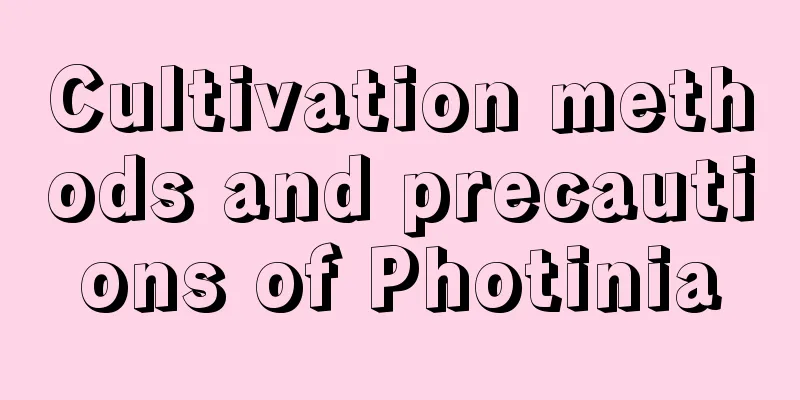Cultivation methods and precautions of Photinia

|
The Chinese photinia has been an important material for making bonsai since ancient times. Its roots and trunks are simple and peculiar, and its posture is elegant. Growing a pot of it at home will look beautiful and grand. So what are the cultivation methods and precautions of Photinia chinensis? Let’s learn more about it below. 1. Soil The Chinese photinia is not very demanding on the soil and is relatively tolerant of poor soil. Loose and fertile humus soil is best for potted plants . River soil or pond soil mixed with sand can also be used. 2. Temperature Since the photinia is native to tropical regions and prefers high temperature and high humidity environments, it has very strict requirements on winter temperatures. When the ambient temperature is below 10°C, the photinia will stop growing and cannot safely survive the winter when frost occurs. The curing temperature should be controlled between 15-21℃. 3. Lighting The photinia prefers partial shade and cannot tolerate direct sunlight. In summer, appropriate shade should be provided to avoid exposure to the sun. In spring and autumn, sufficient sunlight can be provided to promote photosynthesis. 4. Watering The soil of potted Chinese photinia should be kept moist at all times, especially in midsummer when the temperature is high and the weather is dry. Pay attention to watering and spraying water frequently to prevent the soil from drying out. 5. Fertilization During the growing season, apply fertilizers containing nitrogen, phosphorus, potassium and other elements every 1-2 months. When the plant is first planted, you need to wait for 1 month before adding fertilizer to avoid root damage. After entering winter, the growth of photinia quinata is slow and it requires less fertilizer, so you can stop fertilizing. 6. Pruning During the period of vigorous growth, the Chinese photinia needs to be pruned, mainly cutting off overlapping branches, dense branches, overgrown branches, old branches, dead branches, diseased branches, and rotten branches, so as to maintain a good shape and promote the growth of new plum blossoms . 7. Insect prevention The main pests that harm the Chinese photinia are insect pests. If longhorn beetles harm branch trunks, you can apply lime sulfur mixture for prevention and control; if scale insects suck tree sap, you can kill them by manual brushing. 8. Repotting Repotting should be done every 2-3 years, preferably in spring before budding in February or March. Replace some of the old soil, prune the roots of the plant, cut off some of the dead and rotten roots, and perform corresponding root lifting treatments. In general, the Chinese photinia not only has an elegant tree body, but also has a majestic tree momentum. It is a very popular type of home bonsai plant. If you want to grow a healthy and beautiful photinia bonsai, you must be proficient in the above-mentioned cultivation methods and details such as temperature, light, watering, and fertilization.
|
<<: The correct way to grow jasmine
>>: Methods for promoting the flowering of bougainvillea in autumn
Recommend
How often should Hainan Dragon Blood Tree be watered?
How often should Hainan Dragon Blood Tree be wate...
I went to visit a flower grower and found that all the flowers were cut off. The reason was...
Margaret How to shave your head: Margaret's h...
Which flowers are not suitable for rice washing water?
1. Which flowers are not suitable After fermentin...
Treatment methods for black orchid root rot
1. Treatment methods 1. If you find that the root...
How to grow chicory
1. Maintenance methods 1. Temperature: It is a wa...
Olive flower cultivation method
1. Maintenance methods 1. Temperature: It can wit...
Causes and treatments for severe yellowing leaves
1. Improper watering Reason: The heavy fan plant ...
Does Crab Claw Flower like the sun?
Crab claw flower likes the sun Crab claw flower l...
What to do if the gardenia flowers turn yellow
1. Moisture problem (1) Specific reasons: This pr...
Measures for the Protection and Management of Ancient and Famous Trees
During the management period, ancient and famous ...
Cultivation methods and precautions for potted pitaya, how to prune
1. Breeding methods 1. Pot soil: The diameter of ...
Red flesh apples bear fruit in several years
Introduction to growing red flesh apples Red-fles...
Is the lemon tree a shade or sun-loving plant?
Do lemon trees prefer shade or sun? The lemon tre...
How to pinch the tip of gardenia
1. How to pinch the heart 1. Time: The best time ...
Do hydrangeas prefer shade or sun?
Do hydrangeas prefer shade or sun? Hydrangea is v...









